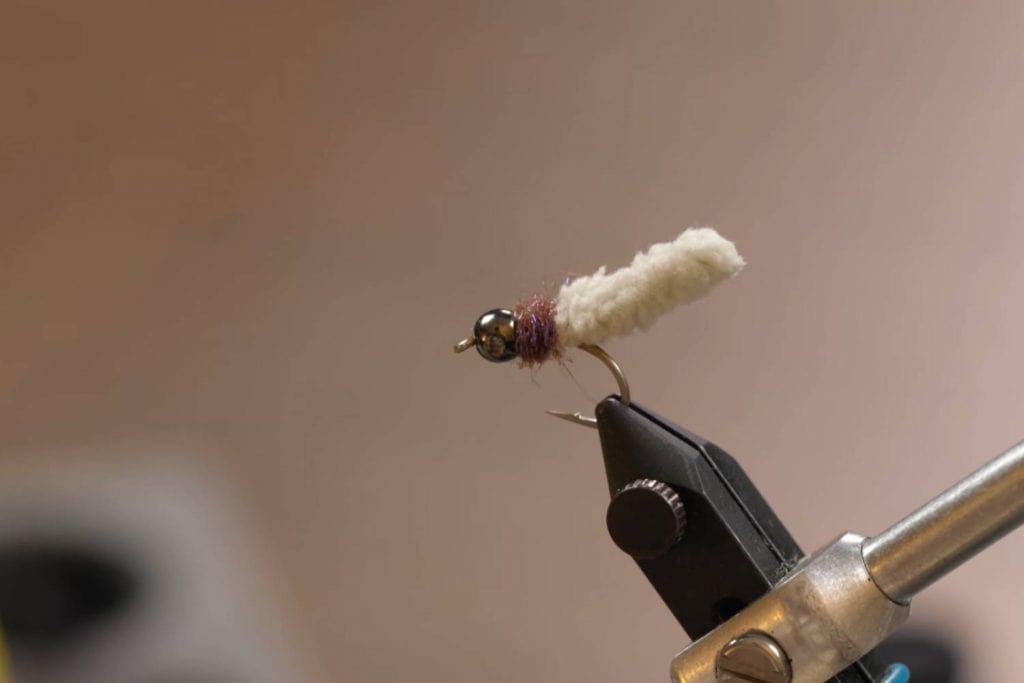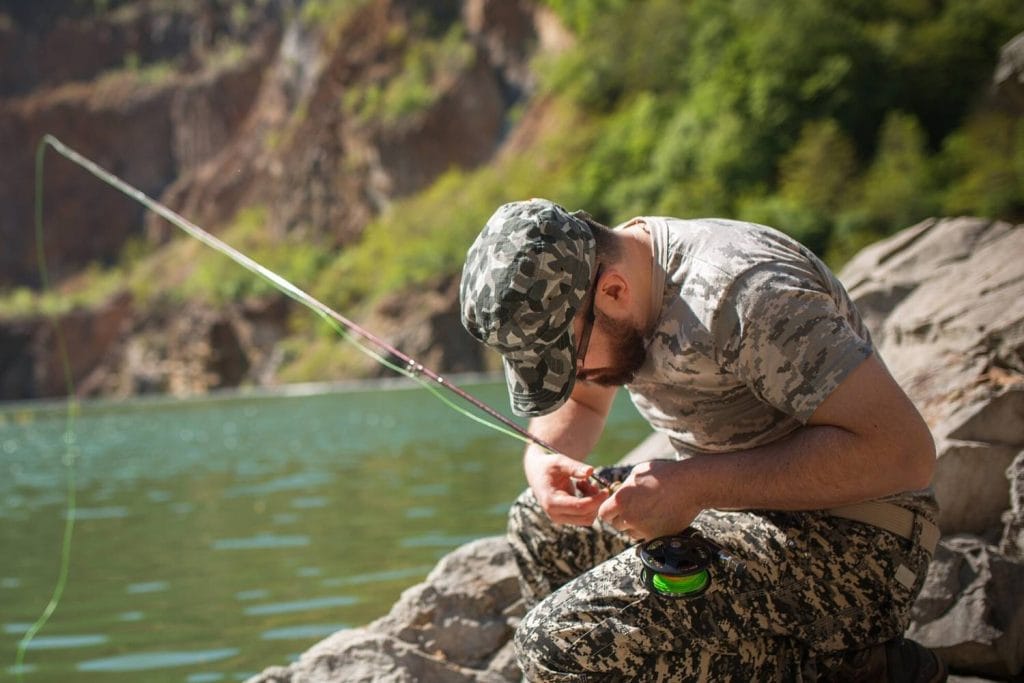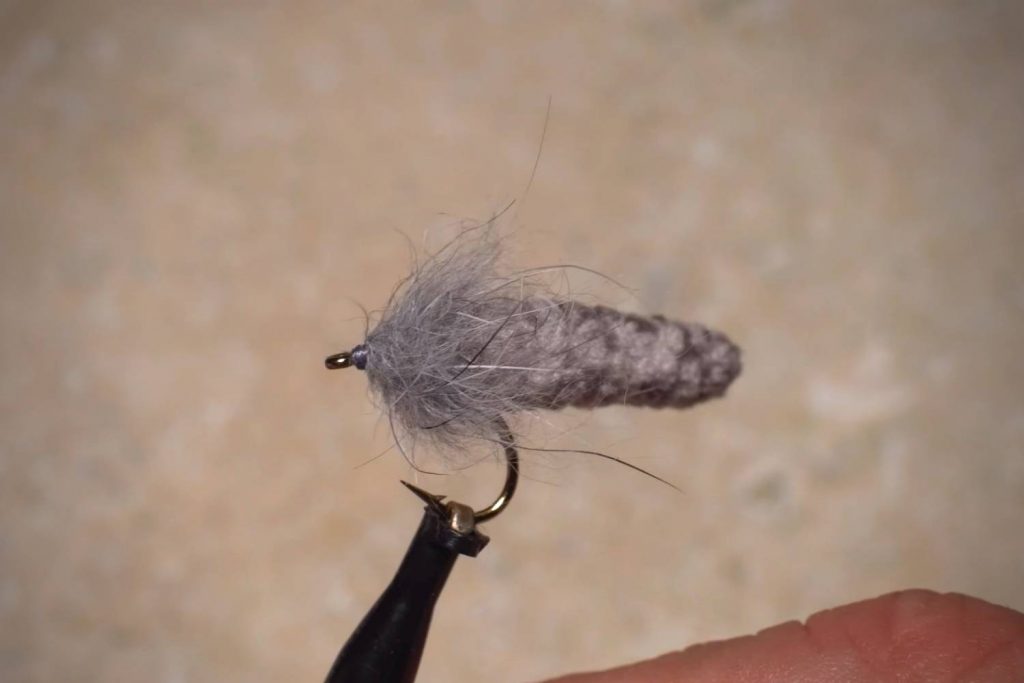You can never have enough flies in your box when fly fishing. It’s easy to go wild at the fly shop, getting a few flies of every fly pattern so you’re always covered if the trout is fussy on any fishing day.
But, it’s often the classics, such as a mop fly, that have worked for years that we anglers seem to forget to load up on. So, what is a mop fly, and how do you fly fish with it?
What is a mop fly?

Mop flies are tied from old carpets or mop material, hence the name, and are about an inch long. They are weighted flies tied with tungsten beads, and you usually find them on a normal j-hook or a jig hook.
Mop flies imitate insect larvae, worms, or grubs usually found near or in damp land surrounding rivers and lakes, and trout, predominantly brown trout, can resist this fly pattern.
Mops can be green, cream, white, and even yellow, and some are tied with dubbing at the bead and others with hackles.
When should you fish the mop fly?
For a fly fisher to catch fish, they need to be able to think about when specific food sources, like worms, grubs, and larvae, enter the river they’re fishing on.
Since grubs and worms are mainly found in the ground surrounding rivers, they end up in the fish’s food chain when a lot of rain and high water has washed them into the system. This is when you fish the mop fly, especially around spring and summer when things start to hatch.
You could use mop flies any time of year, to be honest, even in January during winter, as this juicy pattern is irresistible to fish all year round. But, these patterns are super effective on the water in high water after rain or snowmelt in spring.
What fish can you catch with a mop fly?

Mops are mainly fished to catch trout, but they will work for bass and panfish like crappies too. Pretty much any fish in a river system will feed off grubs, but since trout are pretty aggressive and fished for more than any other species on the fly, they tend to be caught on mops the most.
How do you fish mop flies?
Mops should be fished the same way as a nymph. They are, in essence, a different form of nymphs, being about an inch long with weighted beads at the head, so the best technique to catch fish with mops is with upstream nymphing.
When upstream nymphing with a mop fly, you want to cover pocket water or deep, slow water when cast and let the fly drift naturally in the current. The weight of the bead will sink the fly into the feeding zone of a trout, and as long as the drift is natural, the trout should take the fly, just like with a nymph.
Ideally, you want the mop fly to bounce along the bottom, and you should adjust your rig to determine whether the water is deep, shallow, fast, or slow. We’ll cover the rig in more detail later.
A handy point to note for first-time anglers, whether you’re fishing in a creek, tail waters, or on a large river, is to cover areas near the bank. This is where grubs, worms, larvae, and thus nymphs/mops tend to appear, and the rainbow and brown trout know this and will position themselves in line with it, ready to eat.
How to rig a mop fly for different situations

Start with a generic nymph rig on a weight-forward floating fly line to rig a mop fly. You’ll want about 9 ft of 3/4x or 8/6lb leader. Then tie 3ft of either 4x or 5x fluorocarbon tippet on the leader with a tippet ring or your favorite knot, and finally, tie the mop fly onto the end of your tippet.
Fish are not so finicky about eating mops as they are about a dry fly, so you can go a little heavier on the tippet and leader if you’re after particularly big fish.
Tying a strike indicator to the leader is highly recommended, and make sure it’s brightly colored – chartreuse is my favorite as it’s so easy to see.
Adjusting for depth
If the water you’re fishing is particularly deep, the mop fly might not have enough weight to get to the bottom of your drift. If this is the case, tying on a split shot or two will add the extra weight needed to get it down there. Ensure the split shot isn’t too close to the fly but is a foot or two below the strike indicator.
Another point to mention is to make sure your chartreuse indicator is adjustable, as you’ll want it to be set to the correct depth to keep the mop fly from getting caught on the bottom.
Adjusting for current

As with all fly patterns, you’ll need to adjust your rig for current so the drift looks as natural as possible and the fly gets into the feeding zone.
In slow water, less weight is needed to get a mop fly into the feeding zone as it has more time to sink. This also gives the fish more time to inspect flies, so you could change your tippet to match if you’re getting refusals.
If the river is fast, you’ll want to fish a heavier mop fly or add a split shot to get the flies down quickly enough. You can also risk fishing a heavier tippet as the fish will be caught up in the rush of eating and won’t have time to look closely at the mop fly.
Getting your drift right
One of the hardest things about fishing upstream with mops is getting your drift right. It would be best to make a cast that gives the fly enough time to sink before a fish sees it, but you can’t cast so far past the fish that it sees your fly line and spooks.
The key is ensuring the mop fly is the first thing coming downstream in the water, not your fly line. To do this, you’ll want to mend your line up and over the mop fly once it’s begun to sink.
Also, consider your casting angle and try to make it around 45 degrees. If you cast straight up the river, the fish have way more chance of seeing your rig, and it’s much harder to mend.
The retrieve & hook up

Mop flies should be fished with a dead drift. The mops are tied so that the current gives them enough action, and fish can either eat them aggressively or sip them subtly, hence the need for the indicator.
Keep stripping as the mop fly slowly drifts towards you, keeping in contact with the indicator but not overdoing it to disturb the drift. If you see any signs of the indicator bobbing down, lift your rod to hook the fish, and you should be in.
Fishing the mop on still water
A mop fly will work just as well on still water as on a river. When fly fishing on still water, fish the mop like you would a static buzzer, slowly retrieving with a figure of 8 to keep in contact with the fly so you can set well when a fish eats.
Multiple fly rigs
Mop flies also work when fly fishing multiple fly rigs. Tie the mop fly as the point fly, and add another nymph above it. This can be a deadly combination on rivers and lakes, especially in winter.
Which mop flies should you have in your box?

Like all fly patterns, mop flies come in various shapes, sizes, and colors. It’s always best to have multiple versions in your fishing box to match the water and habits of the fish you’re targeting.
The best colors for mop flies tend to be green and cream, which is my preferred choice, as most grubs are this color, but you should have both. Also, make sure you have mop flies in different weights to match the flow and depth of the water you’re fishing.
Are mop flies easy to tie?
Yes, a mop fly is about as simple to tie as any fly. All you need to do is attach a bead head, tie your mop/carpet material to the back, and finish it with a few raps of dubbing at the head, and it’s good to fish with. Here is an excellent tutorial on how to tie a mop fly.
Why is the mop fly controversial?

The mop fly is and isn’t controversial, but it depends on who you talk to. But there are comments on a fly blog or two that I subscribe to that label the mop a dirty fly.
Fly fishing purists often get their knickers in a twist about whether a fly suits the age-old laws of fly fishing, and in their minds, it’s far more accomplished to catch a fish on a size 22 black knat than on a big old piece of a mop.
You can understand where they’re coming from, and I even agree with them. But fly fishing is meant to be fun, and it’s all about fooling a fish into taking a fly that looks like something they feed on naturally. A mop fly does precisely this, so why not use one?
Whether anyone thinks mops are right or wrong is their opinion, and if you enjoy fishing them and they work for you, then go for it. After all, it’s not as if you’re throwing a spinner across a blue ribbon water and hauling out the biggest fish of the day.
To fly the mop flag or not?

Thanks for reading my article; I hope you enjoyed it and now have the confidence to go out, fish, mop, and even make your own at home.
If you have never fly-fished a mop fly before, I highly recommend doing so. They are deadly and can change one fish day into an eight fish day at the right time of year – after heavy rains and snowmelt.
If you liked the article, we have a load more you might find interesting, too. From great gear to extraordinary destinations and how to fish them, it’s covered here.












2 thoughts on “What Is A Mop Fly And How To Fly Fish With It?”
Appreciate the information you share, very helpful! Enjoyed the article on the mop fly and the technique used to apply to the right conditions. Very helpful and insightful! Thanks
Thanks for the kind words, Jerome. Have a great day!
Comments are closed.